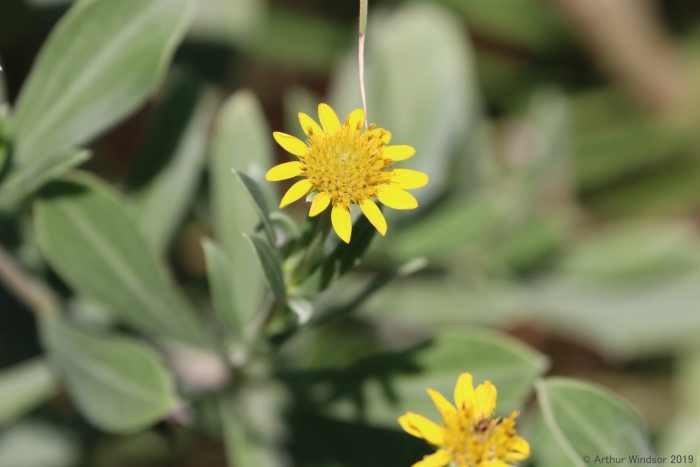Bushy Seaside Oxeye
(Borrichia frutescens)
Bushy Seaside Oxeye (Borrichia frutescens)
/
/

© Arthur Windsor
CC BY 4.0
Image By:
© Arthur Windsor
Recorded By:
Copyright:
CC BY 4.0
Copyright Notice:
Photo by: © Arthur Windsor | License Type: CC BY 4.0 | License URL: http://creativecommons.org/licenses/by/4.0/ | Uploader: arthur-windsor | Publisher: iNaturalist |

















































Estimated Native Range
Summary
Borrichia frutescens, commonly known as Bushy Seaside Oxeye, is a semi-deciduous subshrub native to coastal salt marshes, sandy shores, and dunes of the Southeastern USA and Mexico. It is a perennial herb or shrub that typically reaches up to about 90 centimeters (3 feet) tall. The plant has a robust, bushy form with gray-green to silvery, fleshy foliage that reflects its adaptation to saline environments. The inflorescence is a solitary, rounded flower head with spine-tipped phyllaries, featuring 15 to 30 short, yellow ray florets surrounding a center packed with yellow disc florets and black anthers. After blooming, the head dries into a hard, spiny burr-like structure containing small, dark-colored, triangular cypselas. The plant’s longevity may exceed five years, and it is known to attract butterflies with its flowers.
Bushy Seaside Oxeye is valued for its salt tolerance and ability to thrive in challenging coastal conditions, making it an excellent choice for seaside gardens, restoration projects, and erosion control. It is also used in xeriscaping due to its drought resistance. This species prefers full sun exposure and can adapt to a range of soil types, including those with poor nutrition and varying drainage. It is relatively low-maintenance, requiring only occasional watering once established. However, gardeners should be aware that in non-coastal areas, it may not be as robust and could be susceptible to root rot in poorly drained soils.CC BY-SA 4.0
Bushy Seaside Oxeye is valued for its salt tolerance and ability to thrive in challenging coastal conditions, making it an excellent choice for seaside gardens, restoration projects, and erosion control. It is also used in xeriscaping due to its drought resistance. This species prefers full sun exposure and can adapt to a range of soil types, including those with poor nutrition and varying drainage. It is relatively low-maintenance, requiring only occasional watering once established. However, gardeners should be aware that in non-coastal areas, it may not be as robust and could be susceptible to root rot in poorly drained soils.CC BY-SA 4.0
Plant Description
- Plant Type: Herb, Shrub
- Height: 2-3 feet
- Width: 2-3 feet
- Growth Rate: Rapid
- Flower Color: Yellow
- Flowering Season: Spring, Summer
- Leaf Retention: Evergreen
Growth Requirements
- Sun: Full Sun
- Water: Medium
- Drainage: Fast, Medium, Slow
Common Uses
Erosion Control, Low Maintenance, Salt Tolerant, Street Planting, Water Garden
Natural Habitat
Coastal salt marshes, sandy shores, and dunes
Other Names
Common Names: Bushy Seaside Tansy , Sea Oxeye Daisy , Sea-Marigold , Bushy Seaoxeye , Bushy Seaside Oxeye , Silver Sea Oxeye Daisy
Scientific Names: Borrichia frutescens , Buphthalmum frutescens , Borrichia frutescens var. angustifolia , Diomedea bidentata , Borrichia frutescens var. frutescens , Bubonium frutescens , Buphthalmum incanum , Diomedea linearis , Trimetra ficoidea
GBIF Accepted Name: Borrichia frutescens (L.) DC.